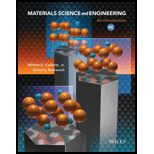
Materials Science and Engineering
9th Edition
ISBN: 9781118324578
Author: Jr. William D. Callister
Publisher: WILEY
expand_more
expand_more
format_list_bulleted
Question
Chapter 2.10, Problem 22QP
To determine
(a). The main difference among ionic, covalent and metallic bonding.
(b). The Pauli Exclusion Principle.
Expert Solution & Answer
Trending nowThis is a popular solution!

Students have asked these similar questions
Qu. 2 The 100-kg crate is subjected to the action of two forces. If it is originally at rest, determine the distance it slides in order to attain a speed of 6 m/s. The coefficient of kinetic friction between the crate
and the surface is uk = 0.2.
i need to show all work step by step problems
A4.2- Develop the column interaction diagram for a tied short column, shown in Figure 2.
Given: f'c = 35 MPa
fy = 400 MPa
Longitudinal bars: 8-35M
Ties: 10M@ 300
Clear cover to the ties: 40mm
T
500 mm
500 mm
Figure 2
1°
⑤
Aa
"Human-written solution required"
2. Using the characteristics of Fig. 6.11, determine ID for the following levels of VGs (with
VDS > VP):
a. VGs = 0V.
b. VGs=-1 V.
c. VGs -1.5 V.
d. VGS
-1.8 V.
e. VGS = -4 V.
f. VGs=-6V.
3. Using the results of problem 2 plot the transfer characteristics of ID vs. VGS-
4. a. Determine Vps for VGs = 0V and Ip = 6 mA using the characteristics of Fig. 6.11.
b. Using the results of part (a), calculate the resistance of the JFET for the region Ip = 0 to
6 mA for VGs =0V.
c. Determine Vps for VGS = -1 V and ID = 3 mA.
d. Using the results of part (c), calculate the resistance of the JFET for the region ID = 0 to
3 mA for VGs -1 V.
e. Determine Vps for VGs = -2 V and ID = 1.5 mA.
f. Using the results of part (e), calculate the resistance of the JFET for the region ID = 0 to
1.5 mA for VGS-2 V.
g. Defining the result of part (b) as ro, determine the resistance for VGs -1 V using
Eq. (6.1) and compare with the results of part (d).
h. Repeat part (g)…
Chapter 2 Solutions
Materials Science and Engineering
Ch. 2.10 - Prob. 1QPCh. 2.10 - Prob. 2QPCh. 2.10 - Prob. 3QPCh. 2.10 - Prob. 4QPCh. 2.10 - Prob. 5QPCh. 2.10 - Prob. 6QPCh. 2.10 - Prob. 7QPCh. 2.10 - Prob. 8QPCh. 2.10 - Prob. 9QPCh. 2.10 - Prob. 10QP
Ch. 2.10 - Prob. 11QPCh. 2.10 - Prob. 12QPCh. 2.10 - Prob. 13QPCh. 2.10 - Prob. 14QPCh. 2.10 - Prob. 15QPCh. 2.10 - Prob. 16QPCh. 2.10 - Prob. 17QPCh. 2.10 - Prob. 18QPCh. 2.10 - Prob. 19QPCh. 2.10 - Prob. 20QPCh. 2.10 - Prob. 21QPCh. 2.10 - Prob. 22QPCh. 2.10 - Prob. 23QPCh. 2.10 - Prob. 24QPCh. 2.10 - Prob. 25QPCh. 2.10 - Prob. 26QPCh. 2.10 - Prob. 27QPCh. 2.10 - Prob. 1SSPCh. 2.10 - Prob. 2SSPCh. 2.10 - Prob. 1FEQPCh. 2.10 - Prob. 2FEQPCh. 2.10 - Prob. 3FEQPCh. 2.10 - Prob. 4FEQP
Knowledge Booster
Similar questions
- (◉ Home - my.uah.edu Homework#5 MasteringEngineering Mastering X + 8 https://session.engineering-mastering.pearson.com/myct/itemView?offset=next&assignmentProblemID=18992146arrow_forward(read image)arrow_forward(◉ Home - my.uah.edu Homework#5 MasteringEngineering Mastering X + 8 https://session.engineering-mastering.pearson.com/myct/itemView?assignmentProblemID=18992147&offset=nextarrow_forward(◉ Home - my.uah.eduarrow_forward(read image)arrow_forward(◉ Home - my.uah.edu Homework#5 MasteringEngineering Mastering X + 8 https://session.engineering-mastering.pearson.com/myct/itemView?assignmentProblemID=18992148&offset=nextarrow_forward① Esterfication + R'on R Hydrolysis OH Alcohol A. 0-R Carboxylic Acid Ester NOD-10arrow_forward(◉ Home - my.uah.edu Homework#5 MasteringEngineering Mastering X + 8 https://session.engineering-mastering.pearson.com/myct/itemView?assignmentProblemID=18992144&offset=nextarrow_forwardA4.3- Design a square short column for P₁ = 1800 kN, Mfx = 250 kN.m, Mfy: f your final design p has to be between 0.01 and 0.02. = 50 kN.m. In Given: f'c = 25 MPa fy = 400 MPa Longitudinal bars: Use 25M Ties: 10M@ 300 Clear cover to the ties: 40mmarrow_forwardarrow_back_iosSEE MORE QUESTIONSarrow_forward_iosRecommended textbooks for you
 MATLAB: An Introduction with ApplicationsEngineeringISBN:9781119256830Author:Amos GilatPublisher:John Wiley & Sons Inc
MATLAB: An Introduction with ApplicationsEngineeringISBN:9781119256830Author:Amos GilatPublisher:John Wiley & Sons Inc Essentials Of Materials Science And EngineeringEngineeringISBN:9781337385497Author:WRIGHT, Wendelin J.Publisher:Cengage,
Essentials Of Materials Science And EngineeringEngineeringISBN:9781337385497Author:WRIGHT, Wendelin J.Publisher:Cengage, Industrial Motor ControlEngineeringISBN:9781133691808Author:Stephen HermanPublisher:Cengage Learning
Industrial Motor ControlEngineeringISBN:9781133691808Author:Stephen HermanPublisher:Cengage Learning Basics Of Engineering EconomyEngineeringISBN:9780073376356Author:Leland Blank, Anthony TarquinPublisher:MCGRAW-HILL HIGHER EDUCATION
Basics Of Engineering EconomyEngineeringISBN:9780073376356Author:Leland Blank, Anthony TarquinPublisher:MCGRAW-HILL HIGHER EDUCATION Structural Steel Design (6th Edition)EngineeringISBN:9780134589657Author:Jack C. McCormac, Stephen F. CsernakPublisher:PEARSON
Structural Steel Design (6th Edition)EngineeringISBN:9780134589657Author:Jack C. McCormac, Stephen F. CsernakPublisher:PEARSON Fundamentals of Materials Science and Engineering...EngineeringISBN:9781119175483Author:William D. Callister Jr., David G. RethwischPublisher:WILEY
Fundamentals of Materials Science and Engineering...EngineeringISBN:9781119175483Author:William D. Callister Jr., David G. RethwischPublisher:WILEY
 MATLAB: An Introduction with ApplicationsEngineeringISBN:9781119256830Author:Amos GilatPublisher:John Wiley & Sons Inc
MATLAB: An Introduction with ApplicationsEngineeringISBN:9781119256830Author:Amos GilatPublisher:John Wiley & Sons Inc Essentials Of Materials Science And EngineeringEngineeringISBN:9781337385497Author:WRIGHT, Wendelin J.Publisher:Cengage,
Essentials Of Materials Science And EngineeringEngineeringISBN:9781337385497Author:WRIGHT, Wendelin J.Publisher:Cengage, Industrial Motor ControlEngineeringISBN:9781133691808Author:Stephen HermanPublisher:Cengage Learning
Industrial Motor ControlEngineeringISBN:9781133691808Author:Stephen HermanPublisher:Cengage Learning Basics Of Engineering EconomyEngineeringISBN:9780073376356Author:Leland Blank, Anthony TarquinPublisher:MCGRAW-HILL HIGHER EDUCATION
Basics Of Engineering EconomyEngineeringISBN:9780073376356Author:Leland Blank, Anthony TarquinPublisher:MCGRAW-HILL HIGHER EDUCATION Structural Steel Design (6th Edition)EngineeringISBN:9780134589657Author:Jack C. McCormac, Stephen F. CsernakPublisher:PEARSON
Structural Steel Design (6th Edition)EngineeringISBN:9780134589657Author:Jack C. McCormac, Stephen F. CsernakPublisher:PEARSON Fundamentals of Materials Science and Engineering...EngineeringISBN:9781119175483Author:William D. Callister Jr., David G. RethwischPublisher:WILEY
Fundamentals of Materials Science and Engineering...EngineeringISBN:9781119175483Author:William D. Callister Jr., David G. RethwischPublisher:WILEY